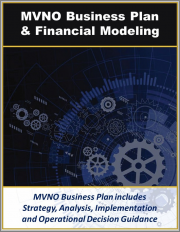
|
시장보고서
상품코드
1661286
MVNO 사업 계획 및 재무 모델링 스프레드시트(2025년)MVNO Business Plan with Financial Modeling Spreadsheet 2025 |
||||||
이 보고서는 Contendus라는 가상 이동 통신 사업자(MVNO)를 설립하기 위해 작성된 완전한 사업계획서입니다. 이 계획은 시장 평가, 자금 조달 요건, 재무 분석, 시장 세분화, 제품 차별화 등 기업 설립 계획의 모든 측면을 다루고 있습니다. 또한 시장 진입 계획, 유통 및 보충 계획, MVNO 비교 등도 포함됩니다. 이 보고서의 가장 큰 장점은 MVNO의 출시 개발을 돕고 기존 계획을 검증하는 데 도움이 된다는 점입니다.
MVNO 사업 계획 및 재무 모델링 스프레드시트 제공
재무 평가를 처음부터 구축할 필요가 없습니다. 이 보고서에는 다음과 같은 재무 모델링이 포함된 엑셀 스프레드시트가 포함되어 있습니다.
|
|
상세하고 실용적인 이 엑셀 스프레드시트는 Contendus의 5년간의 프로포마 정보를 제공합니다. 이 스프레드시트는 분석을 위한 데이터 포인트뿐만 아니라 MVNO 사업 계획의 재무 평가를 위한 고유한 파라미터를 모델링할 수 있는 포맷을 제공합니다.
목차
제1장 개요
제2장 개요
- 사업
- 전략
- 시장
- 경영
- 재무
- 기업의 사명
- MVNO 기준
- 예외
제3장 사업
- 요건 분석
- 서비스 내용
- 타깃 시장
- 초기 서비스 : 주요 수입원
- 향후 잠재적인 서비스 : 추가 수입원
- 분배·구입·보충
- 스타터 패키지
- 단말기와 하드웨어
- LTE 시스템과 SIM 카드
- 웹사이트와 사용자 인터페이스 전략
- LTE의 강화, 5G, 향후 기술
- 백오피스와 고객 케어
- MNO의 요건
- 규제상 문제
- 해약 고려
제4장 기회
- 기회
- 전략
- 프로비저닝과 관리
- 인프라
- 멀티 IMSI 어프로치
- 멀티 네트워크 VPN
- 보안 & 제어
- 예측
제5장 시장
- 미국의 무선 시장
- 선불 서비스 시장
- 도매 통신 서비스
- 교섭에 필수적인 요소
- 셋업 비용 분석
- 단말기 사용과 제어
- 네트워크 사용과 제어
제6장 마케팅 계획
- 개요
- 마케팅 전략
- 초기 시장 부문과 전략적 고려
- 제휴와 공동 브랜드
- 로열티 프로그램
- 이동 전략
제7장 재무 개요
- 수입원과 비용 고려
- 매출 성장
- 재무 예측
- 자금조달
- 출구 전략
제8장 확장 기능과 업그레이드
- 선택 기준
- 기술 요건
- 기타 요인
제9장 잠재적 시장 부문
제10장 경영 팀과 파트너
- 관리
- 자문위원회
- 오퍼레이션 파트너
제11장 경쟁
- 선불 사업자
- 선불 시장 평가
제12장 MVNO 시장 전망
- 개요
- 세계의 전망·예측
- 유럽의 MVNO 추진 요인
- 미국의 MVNO 추진 요인
- 중동의 MVNO 추진 요인
- 아시아태평양의 MVNO 추진 요인
제13장 MVNO 사례 연구
제14장 MVNE, MVNA, MVNX와의 협업
제15장 결론
제16장 부록
데이터 :
표 :
KSA 25.03.12This is a full business plan based on the launch of an illustrative Mobile Virtual Network Operator (MVNO) known as Contendus. The plan covers all aspects of the company launch plan including market assessment, funding requirements, financial analysis, market segmentation, and product differentiation.
Also included is a go-to-market plan, distribution and replenishment plans, comparison of MVNOs and more. The major benefit of this report is to assist in the development of an MVNO launch and to help validate existing plans.
The MVNO Business Plan includes analysis necessary for an MVNO to make crucial implementation and operations decisions, such as working directly with a mobile network operator (MNO) or using an MVNX. An MVNX platform is a comprehensive solution that enables Mobile Virtual Network Operators (MVNOs) to offer a wide range of mobile services to their customers.
- MVNX provides the necessary infrastructure and tools for MVNOs to manage their operations, including network access, billing, customer service, and marketing. It provides the necessary infrastructure and support to compete effectively in the mobile market.
- MVNX platforms act as a crucial bridge between Mobile Network Operators (MNOs) and Mobile Virtual Network Operators (MVNOs), facilitating their collaboration and enabling the growth of the MVNO market. This includes simplifying network access, providing essential infrastructure and services, and reducing costs and accelerating time to market.
MVNO Business Plan Financial Modeling Spreadsheet
Why build your financial assessment from scratch? This includes an Excel spreadsheet with financial modeling including:
|
|
This detailed, working Excel spreadsheet provides pro-forma information for a five-year projection based on assumptions for Contendus. The spreadsheet provides both data points for analysis as well as a format for modeling your own parameters for a financial assessment of your MVNO Business plan.
Table of Contents
1. Executive Summary
2. Overview
- 2.1. The Business
- 2.2. The Strategy
- 2.3. The Market
- 2.4. The Management
- 2.5. The Financials
- 2.6. The Company Mission
- 2.7. MVNO Criteria
- 2.8. Exceptions
3. The Business
- 3.1. Requirements Analysis
- 3.2. Description of Services
- 3.3. Target Market
- 3.4. Initial Services: Primary Revenue Drivers
- 3.5. Potential Future Services: Additional Revenue Sources
- 3.6. Distribution, Purchasing, and Refills
- 3.7. Starter Package
- 3.8. Handsets and Hardware
- 3.9. LTE System and the SIM-card
- 3.10. Website and User Interface Strategies
- 3.11. LTE Enhancements, 5G, and Future Technologies
- 3.12. Back-Office and Customer Care
- 3.13. Mobile Network Operator Requirements
- 3.14. Regulatory Issues
- 3.15. Churn Considerations
4. The Opportunity
- 4.1. Opportunity
- 4.2. Strategy
- 4.3. Provisioning and Management
- 4.4. Infrastructure
- 4.5. Multi-IMSI Approach
- 4.6. Multi-network VPN
- 4.7. Security and Control
- 4.8. Forecast
5. The Market
- 5.1. US Wireless Market
- 5.2. Prepaid Services Market
- 5.3. Wholesale Communications Services
- 5.4. Essential Negotiation Factors
- 5.5. Setup Cost Analysis
- 5.6. Terminal Usage and Control
- 5.7. Network Usage and Control
6. Marketing Plan
- 6.1. Overview
- 6.2. Marketing Strategy
- 6.3. Initial Market Segments and Strategic Considerations
- 6.4. Partnering and Co-branding
- 6.5. Loyalty Program
- 6.6. Migration Strategy
7. Financial Overview
- 7.1. Revenue Streams and Cost Considerations
- 7.2. Revenue Growth
- 7.3. Financial Projections
- 7.4. Funding
- 7.5. Exit Strategy
8. Extensions and Upgrades
- 8.1. Selection Criteria
- 8.2. Technical Requirements
- 8.3. Other Factors
9. Potential Market Segments
10. Management Team and Partners
- 10.1. Management
- 10.2. Board of Advisors
- 10.3. Operational Partners
11. Competition
- 11.1. Prepaid Players
- 11.2. Prepaid Market Assessment
12. MVNO Market Outlook
- 12.1. Overview
- 12.2. Global Outlook and Forecast
- 12.3. MVNO Drivers in Europe
- 12.4. MVNO Drivers in the United States
- 12.5. MVNO Drivers in Middle East
- 12.6. MVNO Drivers in Asia Pacific
13. MVNO Case Studies
14. Working with MVNEs, MVNAs, and MVNX
15. Conclusions
16. Appendix
- 16.1. Cellular Operator Organization Structure
- 16.2. Initiating Contact with MNOs
- 16.3. Strategy Development
Figures:
- Figure 1: MVNOs and Virtual Network Enablers
- Figure 2: MVNO Business Model
- Figure 3: Advanced LTE-based Applications
- Figure 4: Value-add Service Applications
- Figure 5: MVNO Network Planning with MNO
- Figure 6: MVNO Categorization by Business Model Segmentation
- Figure 7: MVNO OSS/BSS Planning
Tables:
- Table 1: MVNO Type and Infrastructure Mapping
- Table 2: MNO vs. MVNO Characteristics
- Table 3: Customer Churn Analysis
- Table 4: MVNO Marketing Strategy
- Table 5: End-User Forecasts
- Table 6: Pro Forma Income Statement
- Table 7: SWOT Analysis
- Table 8: USA vs. Europe Comparative Analysis
- Table 9: Prepaid Penetration Assessment
- Table 10: Prepaid services Distribution and Replenishment



















